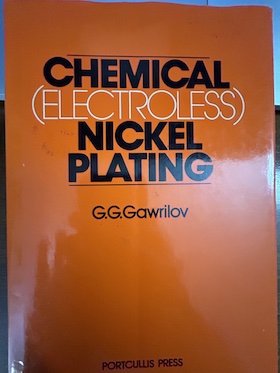
-----
Decomposition/Plate-out of Electroless Nickel Bath
Q. We have an EN plating, but it went out of the bath by itself by forming a foam. What is the cause and the solution?
Matewos Demelash- Addis Ababa, Ethiopia
November 11, 2020
A. Hi Matewos.
1. It is very difficult to assume anything without a detailed information about the type of bath, and what exactly was a problem (photos?).
2. If this is a proprietary EN solution - contact your supplier, they will be the best source of information.
3. Very common problem for EN - bath is out of balance. It has to be proper concentration of Nickel and reducer, correct ratio between them, temperature, pH, proper concentration of additives (stabilizers, complexers). Sometimes, if the additives are out of balance, there is no way to recover the bath, you have to make a new bath.
4. If the problem with plate-out - discard the old bath, clean the tank from Nickel, make a new bath.
- Winnipeg, Canada
A. There are many things that can decompose an EN bath/
Do you filter the solution regulary?
Do you take out the solution and disolve the Nickel at the bottom of the tank?
Do you analyse the solution twise a shift ?
Do you replenish every hour?
Do you keep PH and temperature at the recommended levels?
There is more but this is good for starting.

Sara Michaeli
Tel-Aviv-Yafo, Israel
April 5, 2021
⇩ Related postings, oldest first ⇩
Stopping Electroless Metal plate-out on reaction vessel
Q. My company produces polymers that use some metals including cobalt, titanium, antimony and manganese, as well as, phosphorus as catalysts. The processing temperature is usually above 180 °C and the equipment we use to make the polymer is 304L/316L stainless steels. The polymer is in a non-oxygen containing environment when molten. Our problem is the build-up of cobalt, manganese and antimony phosphides, phosphites or phosphates on the inside of the equipment. This creates many problems as the thin coatings spall off - contamination of the product being #1. It causes greater consumption of the catalyst metals and clean out of equipment becomes quite a pain. Finally, it can play havoc on the reaction rates within the system. I really feel that we have created an enormous electroless metal plating process with the stainless steel equipment acting as a nice catalytic surface. I am looking for any suggestions in stopping this plating reaction.
Thanks.
- Kingsport, Tennessee
2002
by G. G. Gawrilov

on eBay or Amazon
or AbeBooks
(affil link)
A. In the early days of electroless nickel plating, the tanks were made of stainless, and had the difficulty you mention. So platers switched to polypropylene tanks, which were fine until plateout began, then it became uncontrollable. More recently (the last 5-10 years), platers have switched back to stainless tanks but with an impressed current to stop the unwanted catalytic action. You can buy these cathodic protection units commercially from plating equipment suppliers and distributors like Palm International.
Or maybe they're 'anodic protection units'. Drives me crazy trying to remember which one you call them :-)

Ted Mooney, P.E.
Striving to live Aloha
finishing.com - Pine Beach, New Jersey
Ted is available for instant help
or longer-term assistance.
A. Robert,
I don't know if I understood your question , but what you are describing is the formation of metallic salts. If this is the case its not an electroless reaction. For a reaction to be considered plating, (either electrolytic or electroless) you must reduce the salts to the "0" valence state or metallic state. Please give more details to better help you.
Monterrey, NL, Mexico
Q. We have taken scrapings from the inside of the equipment. Elemental analysis shows high peaks for manganese and phosphorus using optical emission spectroscopy and electron dispersive spectroscopy. There were other trace amounts of catalyst metals. Some had high carbon peaks and some results had very little carbon peaks. Since the earlier posting of this inquiry, we have performed more testing. With the larger, more colorful sample amounts we tried to perform x-ray diffraction but no matches to manganese phosphate. It is quite likely that the manganese and phosphorus is tied up in the organic polymer. However, some of the thinner deposits are shiny and metallic looking but there isn't enough sample to run XRD.
Robert Sinko [returning]- Kingsport, Tennessee
2002
Multiple threads merged: please forgive chronology errors and repetition 🙂
Q. Dear All,
I have a big problem with my electroless Nickel bath for ABS.
Plating Line including tanks has newly set up.
In electroless Ni bath, strange hemisphere shaped Nickel (diameter: 1~5 cm) deposited on tank's bottom and filter cartridge in circulation pump. I used carbon cartridge. The bottom of deposits has metal color but outside is dark gray..
Please, let me know a cause or your experience.
Best Regards.
- Seoul, S Korea
2005
A. Hi Bomook. Sounds to me like spontaneous plate-out. Electroless nickel plating isn't easy :-(
What is your tank made of? What brand and type of electroless nickel are you using? Thanks.

Ted Mooney, P.E.
Striving to live Aloha
finishing.com - Pine Beach, New Jersey
Ted is available for instant help
or longer-term assistance.
Q. Thanks for your answers.
Tanks made of PVC.
EL-Ni is alkaline ammonium-citrate type bath.
Thank you.
- S. Korea
A. There are surely many things that I haven't seen that may still be fine, but I've personally never seen a PVC electroless nickel tank; I think polypropylene or cathodically protected stainless steel would be better. The baths I'm familiar with run about 185-190 °F. -- is your bath operating cooler than that?
EN will, of course, spontaneously deposit on any catalytic material. If the tank was not cleaned properly or was improperly filtered, that could be the problem. It could also be a chemical imbalance with insufficient stabilizer, but I'm not an EN chemistry expert. Is this home-brew or a commercial solution? If a commercial solution, the supplier's tech service people should be helping you start up this line. Good luck.

Ted Mooney, P.E.
Striving to live Aloha
finishing.com - Pine Beach, New Jersey
Ted is available for instant help
or longer-term assistance.
A. Some alkaline EN's, especially ammonia
⇦ on
eBay or
Amazon [affil link] based ones operate at a much lower temp. They are also more prone to self destruction if the stabilizer is not maintained in a perfect range.
How is the tank passivated? How often? A critical step, particularly as the tank surface get some wear or roughness.
- Navarre, Florida
A. The EN bath is alkaline and therefore working at R.T.
I think PVC is not bad for Tanks.
I found some clue for spontaneous deposition.
I observed cross-sectioned deposits with SEM and EDS.
As a result, Na, S, Cl, Ca, Pb, etc. is analyzed. Of course, Ni and P were measured. I think these are one of materials of rack coating. What do think of this? Does it make sense?
- Seoul, Korea
A. Alkaline EN baths for plating on plastics are designed to plate at room temperature, and may continue to plate at summer time ambient temperatures, especially if the filter pump is left running. May than likely the inside of the filter began plating, which consumed all of the stabilizers (the Pb and S in the EDS), which then allowed plating to continue in the tank.
In future, turn off the pump, cool the bath if possible, and replenish the bath to its normal range, before shutting down.
From a strength viewpoint, PVC is adequate for the tank for an alkaline EN bath. However, it is more prone to plateout than polyethylene or polypropylene, which are preferred tank materials.

Ron Duncan [deceased]
- LaVergne, Tennessee
It is our sad duty to note Ron's passing on Dec. 15, 2006. A brief obituary opens Episode 13 of our Podcast.
A. I see some good advice in the other answers. However, carbon pack filters cannot be used for this electroless nickel, Carbon will remove a portion of the stabilizers and make the bath unstable.

Don Baudrand
Consultant - Poulsbo, Washington
(Don is co-author of "Plating on Plastics" [on Amazon or AbeBooks affil links]
and "Plating ABS Plastics" [on Amazon or eBay or AbeBooks affil links])
2005
Multiple threads merged: please forgive chronology errors and repetition 🙂
Electroless Ni (White Out) problem
Q. Here at the metal finishing shop of my employment I'm having a Electroless NI problem I was adjusting the ph with ammonium almost a whole point on the ph scale from 4-5 and the bath turned completely white milky color still plates but is plating out need to know a way to fix problem if anybody could help
Aaron GreenTank Maintenance employee - Goucester, Virginia
2007
A. Your employer needs to send someone to school on EN. If a tank needs to operate at pH 5, it should never be allowed to get to pH4. pH needs to be controlled to ±0.1 and no more than ±0.2 pH units.
Your problem was adding concentrated ammonium hydroxide in a large amount. You need to make several small diluted additions. What happened was in the area that you added it, the tank went supercritical and tried to plate out the nickel on everything. You artificially aged the solution, so instead of getting 6 - 10 tank turnovers you will get 4 -6.
A plater or the person that controls the tank chemistry, really needs to go to the vendors school. Typically 2-4 days.
- Navarre, Florida
A. James is right. EN is not chicken feed to control. You need to get more training. Something else, never raise pH when the bath is at its higher level of activity (a very large load just came in, you've just made other additions, some masking just failed and those surfaces are pulling metal like hell, etc.).
Guillermo MarrufoMonterrey, NL, Mexico
Q. I work for small size company in France where I recover some palladium and copper from chloride bath by electrodeposition on a titanium cathode. There are near 100 mg/L palladium as PdCl6/PdCl4/PdCl2 and cuprous chloride (few grams per litre).
Sometimes, I experiment copper deposit on the tank surface around the cathode and sometimes the pump rotor's head. The tank is made of polypropylene plastic. I think the problem comes from palladium chloride which is sometimes used for electroless plating.
How I could avoid the unwanted deposition of metal on the plastic? I need to find a solution other than masking with silicon tape.
Does adding some ions like lead or aluminium could prevent the deposition?
Thank you in advance for your opinion,
mechanical engineer - Rouen, France
April 18, 2013
A. The standard for electroless nickel is bleaching the equipment with concentrated nitric acid. Have you tried it?
Guillermo MarrufoMonterrey, NL, Mexico
Q. Hello everybody!
I have a question about electroless plating. Yesterday was my first time to try how electroless nickel plating works.
In a small beaker [beakers on
eBay
or
Amazon [affil link] I added:
8.8 g Nickel chloride
2.6 g sodium hypophosphite
0.6 g ammonium chloride
0.8 g boric acid
I dissolved all this in 100 mL water
T = 90 °C
pH = 5.1
I plated on a metal plate (the same I use in Hull Cell
⇦ huh?
).
The bath worked for 10 or 15 minutes; after that pH dropped below 2.
I want to know why the nickel is deposited not only on the metal plate which I wanted to plate, but lots of nickel was at the bottom of the beaker?
- Bovec, Slovenia
August 28, 2014
Q, A, or Comment on THIS thread -or- Start a NEW Thread
